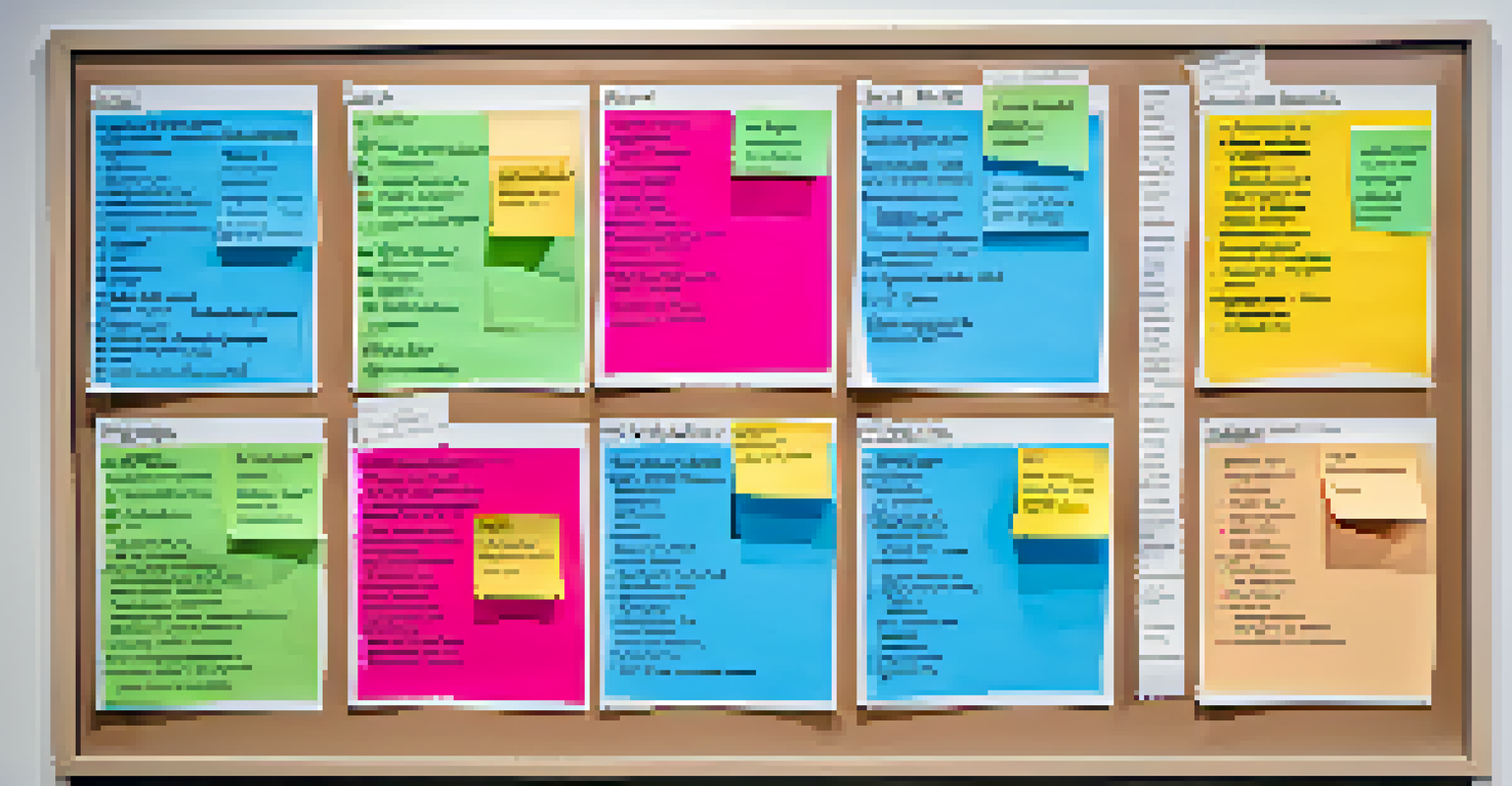Overcoming Procrastination: Time Management Techniques to Try

Understanding Procrastination: Why We Delay Tasks
Procrastination is a common struggle that many people face, often stemming from fear of failure or perfectionism. It’s that nagging feeling of putting off tasks that can lead to a last-minute rush and increased stress. Recognizing why you procrastinate is the first step in overcoming it; it can help you address the root causes rather than just the symptoms.
The secret of getting ahead is getting started.
For example, if you find yourself avoiding a project because it feels overwhelming, breaking it down into smaller, manageable tasks can make a world of difference. Imagine standing at the foot of a mountain; climbing it seems daunting, but taking one step at a time makes the journey feasible. By understanding your triggers, you can create a strategy that works for you.
Additionally, self-reflection can reveal patterns in your procrastination habits. Are there specific times of day when you’re less productive? Is it certain types of tasks that you avoid? By identifying these patterns, you can tailor your time management techniques to better suit your needs.
Setting Clear Goals: The Foundation of Time Management
One effective way to combat procrastination is by setting clear, achievable goals. When your objectives are well-defined, it’s easier to stay focused and motivated. Think of your goals as a roadmap; without it, you may wander aimlessly, but with it, you can navigate your way to success.

For instance, instead of saying, 'I’ll work on my project,' specify, 'I will complete the first draft of my project by Friday.' This clarity not only gives you direction but also a deadline to work towards, which can help instill a sense of urgency. It’s like the difference between saying you want to get fit versus committing to a workout schedule.
Understand Procrastination Triggers
Recognizing the root causes of procrastination, such as fear of failure or perfectionism, is essential for overcoming it.
Moreover, breaking down larger goals into smaller milestones can keep you motivated as you celebrate each small victory along the way. This approach turns daunting tasks into achievable steps, making the process feel less overwhelming and more rewarding.
Prioritizing Tasks: The Eisenhower Matrix Explained
The Eisenhower Matrix is a fantastic tool for prioritizing tasks based on urgency and importance. This technique helps you categorize your tasks into four quadrants, allowing you to focus on what truly matters. Picture it like sorting laundry: you separate whites from colors to ensure everything gets cleaned properly and efficiently.
You can’t build a reputation on what you are going to do.
In the first quadrant, you’ll find tasks that are both urgent and important—think deadlines and critical projects. The second quadrant contains tasks that are important but not urgent, like long-term goals or strategic planning. By prioritizing these tasks, you ensure that you’re not just reacting to urgent demands but also making time for important progress.
Quadrants three and four consist of tasks that are urgent but not important (like some emails or phone calls) and those that are neither (like social media browsing). By delegating or eliminating these lower-priority tasks, you free up time for what truly impacts your goals. This clear structure can make decision-making much simpler.
Time Blocking: A Structured Approach to Your Day
Time blocking is a powerful time management technique that involves scheduling specific blocks of time for different tasks throughout your day. This method can help you stay focused and productive by creating a structured routine. Think of it as setting appointments with yourself—just like you wouldn’t skip a meeting, you shouldn’t skip your dedicated work time.
For example, you might allocate 9 AM to 11 AM for deep work on your project and reserve 1 PM to 2 PM for meetings. By delineating your time in this way, you reduce the likelihood of distractions and procrastination. It’s similar to how athletes train; they stick to a regimented schedule to maximize their performance.
Set Clear, Achievable Goals
Defining specific, actionable goals provides direction and motivation, helping you to stay focused and avoid procrastination.
Moreover, incorporating breaks into your time blocks is crucial. Taking short, regular breaks can recharge your mind and enhance productivity. It’s like sprinting during a race; you need to pace yourself to maintain your energy for the long haul.
The Pomodoro Technique: A Fun Way to Stay Focused
The Pomodoro Technique is a time management method that uses a timer to break work into intervals, traditionally 25 minutes, followed by a short break. This approach can make tasks feel less overwhelming and more manageable. Imagine a sprinter who runs in short bursts—this technique allows you to maintain high energy and focus.
After completing each 25-minute work session, you take a 5-minute break to stretch or grab a drink. This cycle promotes sustained concentration while preventing burnout. It’s a simple yet effective way to keep your mind engaged without feeling exhausted.
As you become accustomed to the Pomodoro Technique, you might find that the short bursts of focused work lead to increased productivity and a sense of accomplishment. It’s a fantastic way to transform procrastination into action, one timer session at a time.
Eliminating Distractions: Creating a Focused Environment
To overcome procrastination, it’s essential to eliminate distractions that can derail your focus. This might mean turning off notifications on your phone, creating a dedicated workspace, or even using apps that block distracting websites. Think of it as clearing the clutter from your workspace; a tidy environment can lead to a clearer mind.
Additionally, consider the power of a focused atmosphere. If you’re easily distracted by background noise, try listening to instrumental music or using noise-canceling headphones. Creating a space conducive to concentration can significantly impact your productivity levels.
Prioritize Tasks Effectively
Using tools like the Eisenhower Matrix allows you to categorize tasks by urgency and importance, ensuring you focus on what truly matters.
Remember, it’s not just physical distractions that matter; mental distractions can be just as disruptive. Practicing mindfulness and meditation can help you train your brain to stay present, allowing you to work more efficiently and effectively.
Reflecting and Adjusting: The Key to Continuous Improvement
Finally, reflecting on your time management techniques is crucial for continuous improvement. After a week or month of implementing new strategies, take some time to assess what worked and what didn’t. This reflection is akin to a coach analyzing game footage to identify areas for growth and enhancement.
Ask yourself questions like, 'Did I meet my goals?' or 'What distractions were most challenging to overcome?' This self-assessment can provide valuable insights into your habits and help you adjust your approach moving forward. It’s a way to ensure that your time management strategies are evolving with your needs.

Additionally, don’t hesitate to experiment with different techniques until you find what resonates best with you. Time management is not one-size-fits-all, and it may take some trial and error to discover what truly enhances your productivity. Embrace the journey, and enjoy the progress you make along the way.